Spectacular displays of fall foliage that are so common throughout much of North America, are relatively rare in central coastal California.
Unlike the deciduous forests in the northeastern United States that provide an abundance of fall foliage, here on the west coast, most of our coastal forests are evergreen, and change little from one season to the next.
Even though our woodlands don’t significantly change color with the seasons, that doesn’t mean that fall passes us by. We just have to look a little more closely to find it.
As we’re expecting rain again this weekend, I took the opportunity this morning to take a brief autumn walk around the property.
The most notable signs of the fall season on the farm can be found in the orchard. The path to the orchard though is getting to be somewhat treacherous.
Our native oaks have been producing an absurd amount of acorns this year. One misstep, and you can quickly find yourself on the ground.
Stepping carefully out to the orchard we find that our fruit trees, especially the peaches and plums, are finally providing a welcome punch of color in our otherwise green landscape.
As beautiful as the ‘Frost’ peach is, we’re a little sad to see the end of the season for this tree. Stripped of much of its cambium below the soil line by meadow voles this spring, come late December this tree will be removed from the orchard. As you can see, this tree is beautifully resistant to peach-leaf curl, so a replacement tree will be planted in January.
Moving through the orchard, the ‘Satsuma’ plum is shedding the last of its leaves.
The pears, like this ‘Bosc’ are turning color too.
This season the ‘Stella’ cherry tree is also showing some fall color. This tree didn’t show much color last season, but this year the leaves are turning a beautiful golden yellow, with just a hint of red.
The fruits on persimmon ‘Chocolate’ are turning color too.
Across the orchard we find Salvia ‘Winifred Gilman’ with some beautiful rust colored seed heads.
Just as we leave the orchard, suddenly an unexpected burst of warm orange from the last of the California Poppies (Eschscholzia californica) in bloom.
Not to be outdone, the last of the Poison Oak (Toxicodendron diversilobum) leaves are changing color for the season.
We remove this plant within the orchard to avoid unnecessary exposure, which typically results in one of us getting a miserably itchy rash. However, it’s an excellent habitat plant, valued by wildlife both for shelter and food, so in the woodland areas we leave it to grow.
The trees surrounding the orchard are primarily still green. In fact, the autumn months see the return of more green throughout the property, usually in the form of various grasses, mosses, and lichens, that reawaken with the first rains.
There are some intermittent splashes of color amongst the greens though. The fruits on the native honeysuckle (Lonicera hispidula) vines are turning vivid red, and will no doubt be relished by the birds that overwinter here.
The hips on our wild wood roses (Rosa gymnocarpa) are also turning a vibrant shade of red too, and provide food for our resident wildlife during the fall and winter months.
The wild birds no doubt will also enjoy the jet-black fruits from the native Coffeeberries (Rhamnus californica) too.
The most significant foliage color from the native woodland trees is being provided by the Big Leaf Maples (Acer macrophyllum).
Their display is brief, and intermittent. Often turning color at the top of the trees first, they shed their leaves quite gradually from top to bottom, so the top of the tree may be yellow, while the bottom is still quite distinctively green.
This typically progresses to the tops of the trees being completely bare, long before the lower leaves finish turning color.
However, the leaves of this tree, the California Tanbark Oak (Notholithocarpus densiflorus), should not be changing color.
This is an evergreen tree, but this year our Tanbark Oaks all across the property are turning brown. They are the most susceptible to sudden oak death here, and no doubt we’ll need to remove more of them come spring.
Shrouded among the fallen leaves of the Big Leaf Maples, and Oaks, small colorful forests of fungi are bursting forth from the damp soils throughout the woodland areas.
This morning, in advance of the approaching rains, I was impressed at the variety of fungi found in the leaf litter this early in the season.
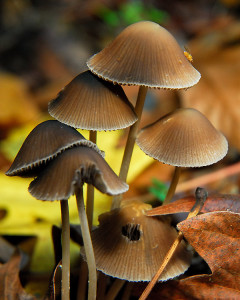
The fallen leaves retain moisture in the soil, keeping conditions favorable for a whole host of species
Including some beautiful clusters of Psathyrella sp. mushrooms.
This large cluster of Coprinosis lagopus, just off the driveway, appears almost frost-touched, although we haven’t yet had any significant frost this season.
As I stood up after photographing this mushroom cluster, I found someone else on an early morning autumn walk. I turned around to find a coyote standing within five feet of me! I was a little down slope, so I don’t think he knew I was there. For a second we both just stood there, and stared at each other. Then suddenly he took off, turned the corner, and he was gone. One of those perfect shots that got away, because I couldn’t get the macro filter off the lens fast enough. Oh well, I’m sure there’ll be a next time.
After that close encounter, turning my attention back to the leaf litter, I found one of many brightly colored banana slugs. We don’t trap slugs on the farm to protect this species, as they are an important part of our redwood forest ecosystem.
Their vibrant yellow color blends in well with the Big Leaf Maple, and California Bay Laurel leaves on the forest floor.
Beneath the trees, the native, deciduous, Western Bracken Ferns (Pteridium aquilinum) are also changing color with the season.
Although most of the foliage is turning a warm brown, a touch a golden yellow lingers on a few of the fern’s leaves. This stand of ferns just in front of the house is approximately 4 feet tall. Our resident deer, especially the young fawns in late spring and summer, often sleep secluded under their enormous leaves.
The fall colors on the farm may not be as spectacular as in some areas of the country, but there’s no denying that the seasons are definitely changing.

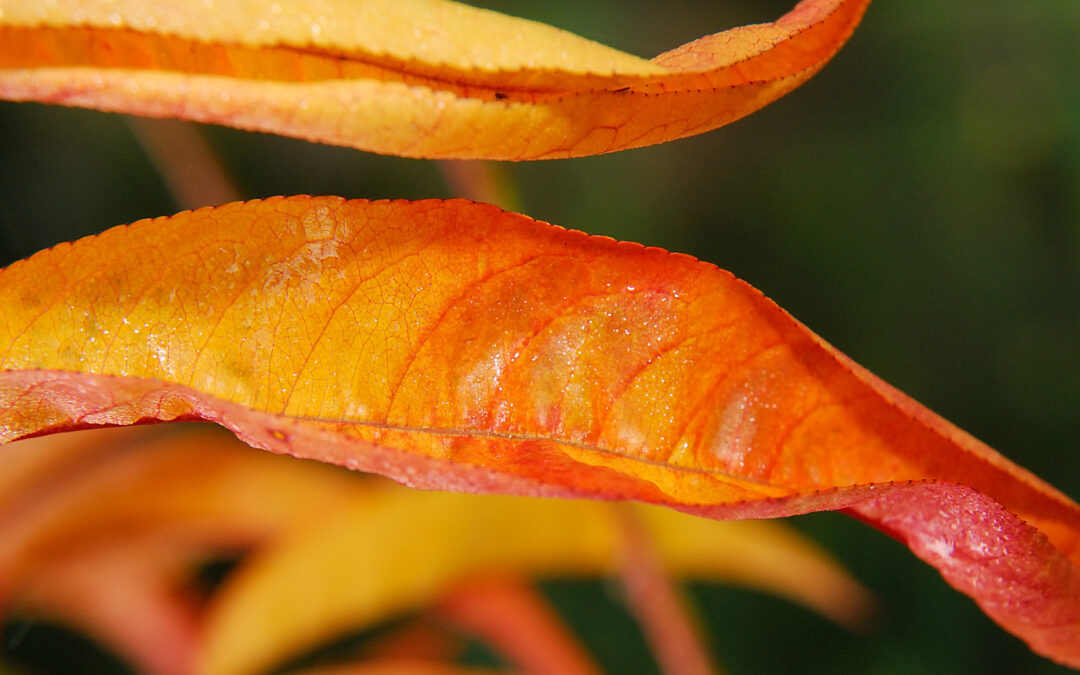
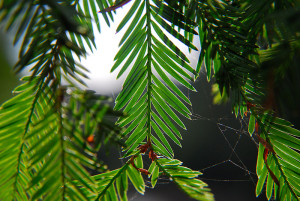
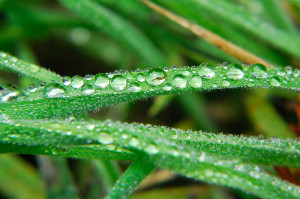

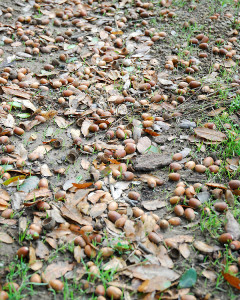
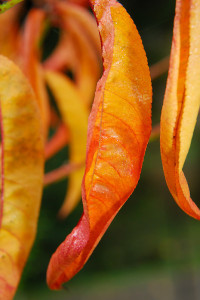
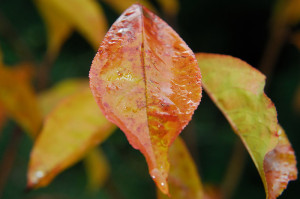
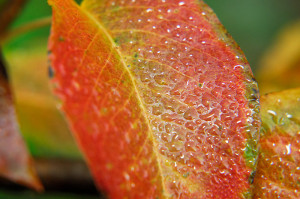
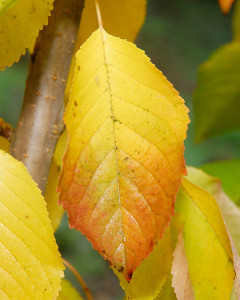
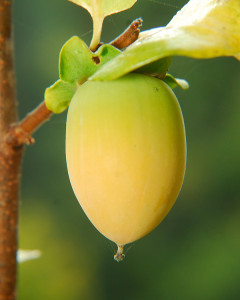
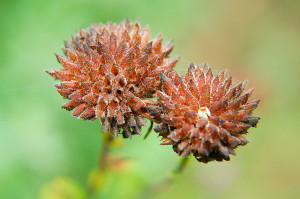
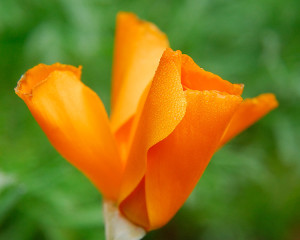
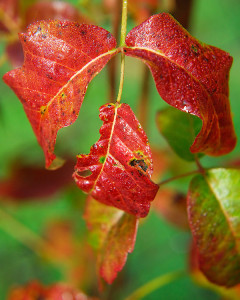

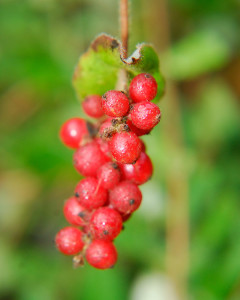

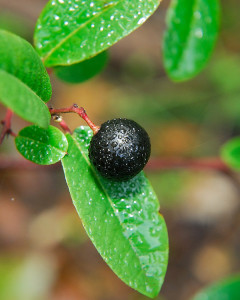
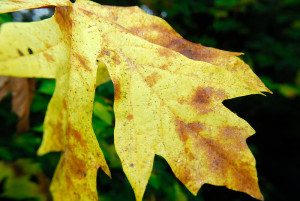
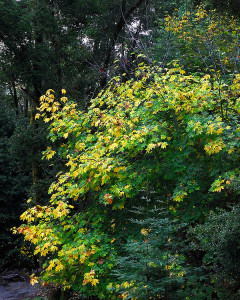
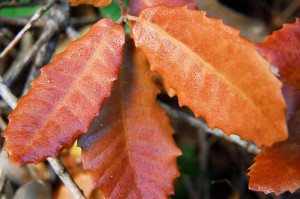
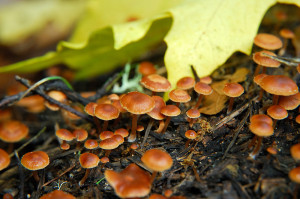
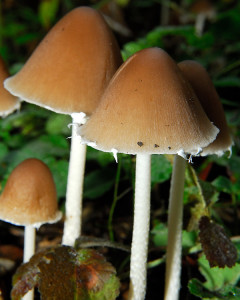
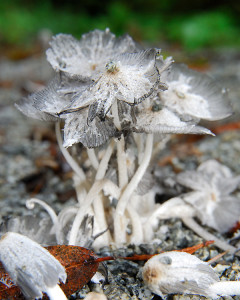
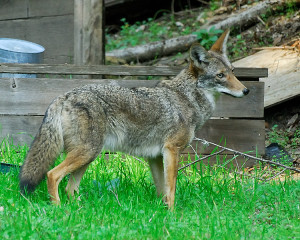

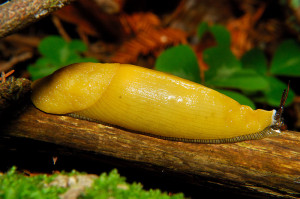
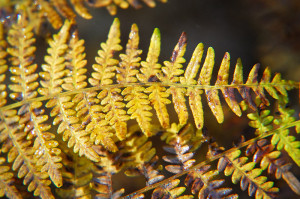








Clare, I love the delicate color changes that you have in your garden~but, you can keep the banana slugs! I want a true macro lens when I see the texture of fungi~it’s so intricate and wonderful. We have coyote but, I’ve not had the pleasure of a meeting. Deer, I do see, they stop by for Bur Oak acorns! gail
That’s probably why we have so many acorns on our orchard path…the deer can’t (at least not anymore) get to the orchard! 😉 Although we’ve had a lot on the road too, but here the acorns tend to collect in particular spots at the bottom of the a slope as they roll down hill.
Poor banana slugs, it’s difficult to convince people, especially gardeners, that slugs aren’t all bad guys. We might not even have redwood forests without these creatures.
They do have an image problem. I would have to argue with myself, not to run shrieking into the night! They are too large, and MUCH too yellow to be true.
You’re right Diana, they are a rather alien color, and much larger than the average slug! 😀
Love your macro look at Fall, lovely images, especially those rain dropped ones. The coyote is sort of cute, but I be not to the chickens.
The chickens definitely don’t think the coyotes are cute. Nor does our Tom turkey who had a run in with a small pack of them earlier this year. I was just amazed how quickly the coyote managed to disappear into the woods. Tricky fellow! 😉
I just wish that I have enough Fall color where we live :). I enjoy my virtual tour in your Fall garden. Thank you.
I agree, sometimes I see beautiful images of forests and woodlands in Massachusetts, or New York state, and long to see displays like that here. However, fall here is beautiful too, and often quite warm, allowing us garden much later into the year, and I enjoy that even more. 🙂
Your fall colors, if not abundant, are beautiful indeed. The photo of the coyote is nice. He looks healthy, sleek, and shinny. He can just stay away from the hen house. Once again amazing photos of the beautiful foliage in N. California.
This particular coyote was a brazen one a couple of years ago that was lurking right by the coop door. It’s one of the few times that the coyote and my camera have been in the same place at the same time. 😛 The fellow I saw yesterday I’m almost certain is the same raggedy one that I caught photos and video of earlier this year when he went after our rooster. His coat is very distinctive, as if he has mange.
Clare, your fall is beautiful! Fungi are such little wonders! I love your Coprinopsis lagopus especially! Yes, we have the same Big Leaf maple. Some of the trees don’t have so huge leaves as I found on my walk and showed in my last post.
I couldn’t get over the size of the leaves you found! 😯 They were HUGE! Although none of our trees are probably taller than about 45-50 feet. There aren’t many either. I think they have to compete too much with the redwoods and firs that are much taller. A few of them also seem quite susceptible to a disease that causes branch die back, and leaves look spotted and blotched (Phytophthera perhaps?). Most of the year they blend into the woodland, but it is fun to see them change color in fall when everything else is green!
Hi Claire – What wonderful photographs – I love the “Leaves of ‘Bosc’ Pear” photo, the enlarge version with the raindrops – what a wonderful capture. Another of Nature’s gorgeous patterns; raindrops on beautifully patterned leaves. Magical!
Your climate seems to be quite similar to ours – we don’t have the spectacular fall “showing” I see on many of the blogs I follow, but it is a beautiful time of year regardless, in your part of the world, and mine 🙂
Those banana slugs … yikes!
Our fruit trees are all still quite young, and this is the first fall they’ve showed much color at all. I expected the leaves on the pears might all be yellow, but I love the ‘Bosc’, it’s much more red than I expected.
It is a beautiful time of year. Rather than covet the fall leaves and displays from somewhere else, it was fun to look for our own fall beauty here, both large and small. 🙂
It seems to be the year of the acorns. I have more than ever. I wonder if that means we are in for a cold winter? Your persimmon ‘choclate’ have a completely different shape to the persimmon I grow. I love their shape. Will they turn orange too? How do they get their name? Your fungi shots are spectacular! And, wow, a run in with a coyote! That would be so exciting!
I’ve wondered why acorn production seems so ramped up this year. For weeks, if you walk out of our front door, and just stand there, you can hear all the acorns falling out of the trees. Some places aren’t safe to stand without getting bonked in the head by them! I’ve also noticed many more berries on the native honeysuckles this year too. It will be interesting to see how this winter shapes up. If nothing else, the squirrels won’t starve 😛
The persimmon ‘Chocolate’ fruits will get a little wider. They’re more oblong, Hachiya-like in shape. They will turn the classic deep orange. They’re named ‘Chocolate’ for their brown flesh when cut, that has a somewhat cinnamon-like flavor. This is the first year for this tree to fruit, and we only allowed a few to set this year. I’m excited to see how they turn out!
Clare what a beautiful fall full of special surprises..lots of wonderful sights!!
It was a fun walk. One of those mornings where I’m not sure what I’ll post about, but after a walk I come back with enough material for 5 or 10 posts! 😉
Oh my what a spectacularly colourful fall you have! The Maples – wow! And the interesting fungi. What a lovely feast for the eye! Loved it! THank you.
It’s a lot more colorful than I initially gave it credit for. The trick to finding it all was not to just look up into the canopies of the trees, but also to look down! 🙂
Clare, I enjoyed the tour of your Fall garden. The Psathyrella are little beauties aren’t they? We alo have to be careful on our sloping paths covered with acorns. I had to laugh…it’s like someone threw out a bag of marbles underfoot.
Marbles…that’s it exactly! I’m amazed I haven’t twizzled an ankle (knock wood). I’ve certainly gone skidding along a few times though, especially on the path in that first photo. I keep expecting the squirrels to come by and clean them all up, but I may just have keep raking them to one side for now, that or pile them up outside the deer fence so the deer can get to them 😉
How lovely to share the walk, Clare. Delightful images and truly felt beside you in your warm and wondrous beauty … I so love ferns and fungi!
Glad you could stop by Joey. I love the ferns and fungi too. The bracken fern is the only one of our native ferns that changes color here, but we’re fortunate to have a number of fern species here year around!
That’s always so sad to have to remove trees! I enjoyed your images of the change of seasons. That must have been quite the surprise to see the coyote so close! I’ve never seen one though I’ve lived in places where we could hear them before.
Do you feel the same way about the voles as you do about the slugs?
Haha! No, the slugs definitely rate better than voles around here. They are MUCH less destructive. In fact, I very rarely even find the banana slugs in the vegetable gardens. I expect they find much tastier treats that they prefer in our woodland.
I smiled when I saw your acorn-covered path. The white oaks in N.C. also have had a banner year. One towers over our house and when gusts of wind blew, the acorns rattled on the roof. Thanks for an interesting tour of fall in California. I’m jealous of your fruit trees – especially the cherry!
Thanks for stopping in Sheila. It does seem that acorns are plentiful in many parts of the country this year. I’ll be curious to see if our oaks set as many next year. I’ve never seen so many!
I think you pretty much found Fall, Clare. Beautiful images!
After lamenting that we had little fall color to speak of, I think you’re right! I just wasn’t paying close enough attention before 😉
You might not have the fall colors we have but there are certainly a lot of beautiful fall flora and fauna at your farm.
We’re very lucky to have the diversity we have. I just need to learn not to covet thine neighbor’s trees, and appreciate what we do have 😛
Clare, this post brought back lots of memories of my time on the west coast. Southern British Columbia has a similar climate and the rainforest really doesn’t show signs of autumn like it does in the east. I loved the photo of the big leaf maples, the enormity of the leaves never fails to impress me. It’s funny but our orchard here provides the least amount of colour of all our trees. The apples are the last trees to turn colour and fall but it’s just a tan/gold colour. Nothing as impressive as your peaches and plums.
Even here the apples are drab, and so are some of the pears. Although I say that, but truth is our trees are all still quite young. I expect the peaches and plums though will always outshine the fruit trees in the orchard…perhaps with the exception of the persimmon. I can’t wait until our trees are larger and have a little more presence on the slope in the fall.
Well you certainly found some lovely fall colours and I never thought I would see myself writing that a slug was a very nice colour! I’ll send you over some of our squirrels to help you with your acorn harvest!
Clearly our squirrels are overfed 😛 I’m just amazed with as quickly as they rob the orchard fruits, that the acorns are just laying there on the ground.
I do think the banana slugs are quite stunning…for slugs 😉
Clare – you have a way with photos and words that give your readers a sense they are walking beside you on your early morning walk. I especially appreciate your viewpoint of the ecosystem on the farm and the inhabitants as they move around.
Thank you Shyrlene, I’m glad you enjoyed the walk. Sometimes I feel a little bad that we grow anything here, other than the plants that naturally grow in our woodlands. Although in the fall, I’m grateful for that little splash of color among the green, and the increased diversity does seem to be attracting different creatures to the farm too. 🙂
At first I thought your acorn covered path was gravel! We also have an abundance of acorns, much loved by the resident squirrels. Your encounter with the coyote sounds a little scary; I’m glad he didn’t show any aggression toward you. I’m sure he was as startled as you.
Your fall colors are lovely, beautiful accents to the greens. I like evergreens as they provide structure and interest throughout the winter.
It does almost look like gravel, although I expect gravel would be easier to walk on! 😉
That coyote definitely surprised me. It was quite an engaging encounter as we sized each other up. He seemed in quite a hurry to move on though, and I can’t blame him.
I tried photographing the big leaf maples along the creek near our home – they look so vivid, I love their yellow. Course the brown-tinted sunglasses help too! But I didn’t get any good shots. Some things just don’t come across. Lots of fall changes to note around here – thanks for all of yours.
I’ve taken a lot of photographs of the Big-Leaf Maples, both in fall, and in spring with their ‘blooms’. You’re right, it’s difficult to get those images to translate into what you’re seeing in person. I’m almost never happy with how the photographs of those trees turn out. Maybe I should get a brown-tinted lens filter 😛